#saint brigid's cathedral
Text

Saint Brigid's Cathedral, Kildare Town, Ireland and the round tower and high cross on a sunny day.
#ireland#vsco#landscape#vscocam#irish#photographers on tumblr#photography#travel#kildare#gaa#squires gannon#panorama#panoramic ireland#county kildare#irish buildings#heritage#saint brigid#saint brigid's cathedral#round tower#sam maguire cup
42 notes
·
View notes
Text
Today the Church remembers St. Aelred of Riveaulx, Monk.
Ora pro nobis.
Aelred of Rievaulx (1110 – 12 January 1167 AD) was an English Cistercian monk, abbot of Rievaulx, in Yorkshire, England, from 1147 AD until his death. He was also a writer of several theological volumes.
Aelred was born in Hexham, Northumbria, in 1110, one of three sons of Eilaf, priest of St. Andrew’s at Hexham, himself a son of another Eilaf, treasurer of Durham. In 1095, the Council of Claremont had forbidden the ordination of the sons of priests. This was done in part to end the inheritance of benefices.[3] He may have been partially educated by Lawrence of Durham, who sent him a hagiography of Saint Brigid.
Aelred’s early education was probably at the cathedral school at Durham. Aelred spent several years at the court of King David I of Scotland in Roxburgh, possibly from the age of 14, rising to the rank of echonomus (often translated “steward” or “Master of the Household“) before leaving the court at age twenty-four (in 1134) to enter the Cistercian abbey of Rievaulx in Yorkshire.
In 1138, when Rievaulx’s patron, Walter Espec, was to surrender his castle at Wark to King David of Scotland, Aelred reportedly accompanied Abbot William of Rievaulx to the Scottish border to negotiate the transfer. He saw that his reluctance to part from his friends at court, delayed his adopting his monastic calling. For Aelred, the source and object of true friendship is Christ.
In 1142 Aelred travelled to Rome, alongside Walter of London, Archdeacon of York, to represent before Pope Innocent II the northern prelates who opposed the election of Henry de Sully, nephew of King Stephen, as archbishop of York. The result of the journey was that Aelred brought back a letter from Pope Innocent summoning the superiors whom Aelred represented to appear in Rome the following March to make their deposition in the required canonical form. The resulting negotiations dragged on for many years.
Upon his return from Rome, Aelred became novice master at Rievaulx. In 1143, he was appointed abbot of the new Revesby Abbey, a daughter house of Rievaulx in Lincolnshire. In 1147, he was elected abbot of Rievaulx itself, a position he was to hold until his death. Under his administration, the abbey is said to have grown to some 140 monks and 500 conversi and laymen.
His role as abbot required him to travel. Cistercian abbots were expected to make annual visitations to daughter-houses, and Rievaulx had five in England and Scotland by the time Aelred held office. Moreover, Aelred had to make the long sea journey to the annual general chapter of the Order at Cîteaux in France.
Alongside his role as a monk and later abbot, Aelred was involved throughout his life in political affairs. The fourteenth-century version of the Peterborough Chronicle states that Aelred’s efforts during the twelfth-century papal schism brought about Henry II’s decisive support for the Cistercian candidate, resulting in 1161 in the formal recognition of Pope Alexander III.
Aelred wrote several influential books on spirituality, among them Speculum caritatis (“The Mirror of Charity,” reportedly written at the request of Bernard of Clairvaux) and De spiritali amicitia (“On Spiritual Friendship”).
He also wrote seven works of history, addressing three of them to Henry II of England, advising him how to be a good king and declaring him to be the true descendant of Anglo-Saxon kings.
In his later years, he is thought to have suffered from the kidney stones and arthritis. Walter reports that in 1157 the Cistercian General Council allowed him to sleep and eat in Rievaulx’s infirmary; later he lived in a nearby building constructed for him.
Aelred died in the winter of 1166–7, probably on 12 January 1167, at Rievaulx.
O God, by whose grace your servant Aelred, kindled with the flame of your love, became a burning and a shining light in your Church: Grant that we also may be aflame with the spirit of love and discipline, and walk before you as children of light; through Jesus Christ our Lord, who lives and reigns with you, in the unity of the Holy Spirit, one God, now and forever.
Amen.
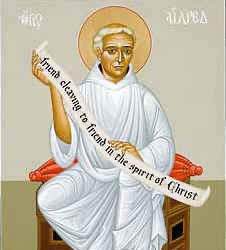
3 notes
·
View notes
Text
Prompt 22: Veracity
FFXIV 30 Day Writing Challenge
Prompt 22: Veracity
Iolaire belongs to the dear @corbix.
Ishgard was a nation built on lies. Nearly everything about it, from the origins of the church, to the stories certain married men told their unfortunate wives, was an utter lie. The cause of the War was a lie. The Four Houses were only important because of lies.
There was very little truth to be found in Ishgard, but it was there if you looked for it. Aymeric was far too truthful, even though he could skillfully wrap his words in politics palatable for the others. His face gave away much, bless him. Haurchefant had long since stopped caring what others thought and lived as truthfully as he could. It wasn’t as though he had a personal reputation to ruin, after all, as far as the upper crust was concerned.
There was truth in Brigid and Iolaire.
They found Ishgard’s truth, the thousands and thousands of truths that had been waiting for someone to find them, to spread them far and wide. Though it shattered the beliefs of Iolaire’s countrymen, the pair of them made certain it was known and could not be hidden again.
There was truth in their eyes and on their lips as they took each other’s hands in Saint Reymanaud’s Cathedral that Waterday and swore themselves to each other under the Fury’s gaze. Truth in their love and their certainty in each other.
It was a truth that was also spread far and wide, one proclaimed loudly and not spread through hushed whispers. All knew of the love the Warriors of Light shared, and all knew of the happiness it brought them and others.
Even Estinien, stood in the back as part of the honor guard, had to admit it was a lovely ceremony. His Idiots.
#FFXIVWrite2022#FFXIVWrite#Warrior of Light: Brigid O'Donnell#Husband of Light: Iolaire O'Donnell#Yeah okay I know it's a prompt early for the anniversary but it's the 23rd when I'm posting#numbers and I aren't great and I'm tired#Also yes Estinien has to deal with them as often as possible that's the rule#Pairing: For the Dancing and the Dreaming
4 notes
·
View notes
Text
Labyrinths and Lent
“We are all broken in some way. But those of us who embrace our brokenness will be transformed.” Julianne Stanz Author of Braving the Thin Places
CONTINUE YOUR JOURNEY -February 11, 2024
Brigid Bytes
Well in the Crypt at Chartres Cathedral
New Year – New Format- Brigid Bytes
All is greening. Last week’s workshop on Brigid was a big hit. Brigid, goddess, and saint is new to me,…

View On WordPress
0 notes
Text
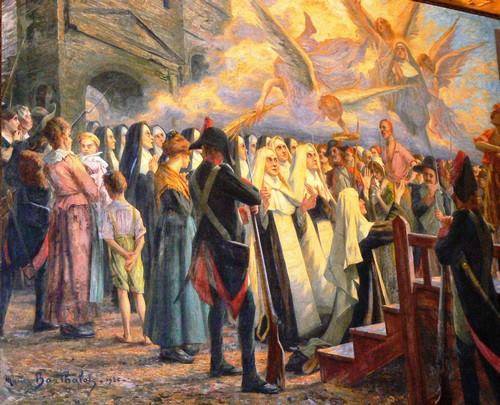
SAINTS FOR FEBRUARY 01
St. Seiriol, 6th century. Welsh monk and hermit, He is honored on Puffin Island (island of Ynys-Seiriol), off the coast of Anglesey, Wales. Other details of his life are scarce.
Martyrs of the French Revolution February 01
Bl. Anne Hmard, Bl. Anne-Francoise de Villeneuve, Bl. Catherine Cottenceau, Bl. Francoise Bonneau, Bl. Francoise Michau, Bl. Francoise Pagis Roulleau, Bl. Gabrielle Androuin, Bl. Jeanne Bourigault Bl. Jeanne Fouchard Chalonneau, Bl. Jeanne Gruget Doly, Bl. Jeanne-Marie Sailland d'Epinatz, Bl. Louise Rallier de la Tertiniere Dean de Luigne, Bl. Louise-Aimee Dean de Luigne, Bl. Madeleine Blond, Bl. Madeleine Cady, Bl. Madeleine Perrotin Rousseau, Bl. Madeleine Sailland d'Epinatz, Bl. Madeleine Salle, Bl. Marguerite Riviere Huau, Bl. Marguerite Robin, Bl. Marie Cassin, Bl. Marie Grillard, Bl. Marie Lenee Lepage Varance, Bl. Marie Leroy Brevet, Bl. Marie Pichery Delahaye, Bl. Marie Roualt Bouju, Bl. Marie-Genevieve Poulain de la Forestrie, Bl. Marie-Jeanne Chauvigne Rorteau, Bl. Marthe Poulain de la Forestrie, Bl. Marie-Jeanne Chauvigne Rorteau, Bl. Marthe Poulain de la Forestrie, Bl. Perrine Androuin, Bl. Perrine Besson, Bl. Perrine Bourigault, Bl. Perrine Grille, Bl. Perrine Laurent, Bl. Perrine Ledoyen, Bl. Perrine Phelyppeaux Sailland, Bl. Perrine-Jeanne Sailland d'Epinatz, Bl. Perrine-Renee Potier Turpault, Bl. Renee Grillard, Bl. Renee Marie Feillatreau, Bl. Renee Martin, Bl. Renee Regault Papin, Bl. Renee Seichet Dacy, Bl. Renee Valin, Bl. Rose Quenion, Bl. Simone Chauvigne Charbonneau, Bl. Suzanne Androuin, Bl. Victoire Bauduceau Reveillere, Feb. 1 Pierre Tessier was a Roman Catholic layman and a martyr
B. LUDOVICA ALBERTONI, ROMAN WIDOW
St. Brigid of Ireland. Brigid was probably born at Faughart near Dundalk, Louth, Ireland. Her parents were baptized by St. Patrick, with whom she developed a close friendship. According to legend, her father was Dubhthach, an Irish chieftain of Lienster, and her mother, Brocca, was a slave at his court. Even as a young girl she evinced an interest for a religious life and took the veil in her youth from St. Macaille at Croghan and probably was professed by St. Mel of Armagh, who is believed to have conferred abbatial authority on her. She settled with seven of her virgins at the foot of Croghan Hill for a time and about the year 468, followed Mel to Meath. About the year 470 she founded a double monastery at Cill-Dara (Kildare) and was Abbess of the convent, the first in Ireland. The foundation developed into a center of learning and spirituality, and around it grew up the Cathedral city of Kildare. She founded a school of art at Kildare and its illuminated manuscripts became famous, notably the Book of Kildare, which was praised as one of the finest of all illuminated Irish manuscripts before its disappearance three centuries ago. Brigid was one of the most remarkable women of her times, and despite the numerous legendary, extravagant, and even fantastic miracles attributed to her, there is no doubt that her extraordinary spirituality, boundless charity, and compassion for those in distress were real. She died at Kildare on February 1. The Mary of the Gael, she is buried at Downpatrick with St. Columba and St. Patrick, with whom she is the patron of Ireland. Her name is sometimes Bridget and Bride.
St. Cinnia, 5th century. A princess of Ulster, Ireland. She was converted to Christianity by St. Patrick. When she entered a convent, St. Patrick gave her the veil.
St. Crewanna, 5th century. A confessor who accompanied St. Breaca from Ireland to Cornwall, England. Crowan near St. Erth is believed to have been named in his honor.
St. Darulagdach, 524 A.D. Abbess of Kildare, Ireland, the successor of St. Brigid. She is also called Dardulacha.
St. Jarlath, 480 A.D. Also called Hierlath, Irish bishop and disciple of St. Patrick. He became bishop of Armagh and aided monastic expansion and the missionary program undertaken in that era.
St. Kinnin, 5th century. Irish maiden baptized by St. Patrick. She is venerated in County Louth, Ireland.
0 notes
Photo
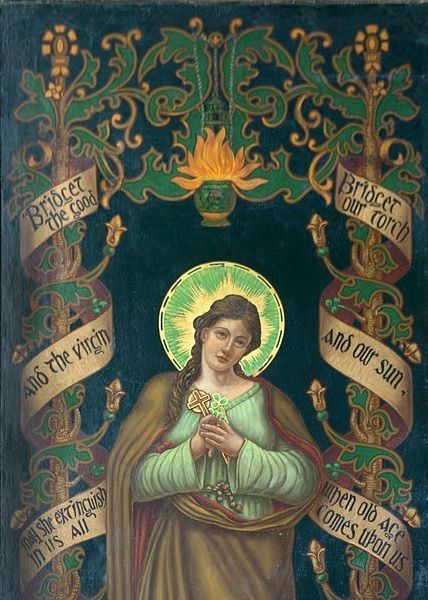
The Woman Who Helped Forge Irish Catholicism - St. Brigid - Feast Day - February 1st
Strength, Grit and Faith
Saint Brigid, known as ‘Mary of the Gael,’ is one of Ireland’s most beloved saints. Along with Saint Patrick and Saint Columba, she is a patron saint of the Emerald Isle. Her influence was as essential as St. Patrick’s in the spread of Catholicism among the Irish, and her story is equally remarkable. Her strength, grit, and faith helped forge the character of Irish Catholicism.
Brigid was born in 451 at Faughart near Dundalk, Louth, Ireland to a pagan father and a Christian mother. Her father, Dubhthach, was a pagan chieftain of Leinster. Brigid’s mother, Brocca, was a Christian slave in her father’s court. St. Patrick eventually baptized the entire family, though the family faced many difficult obstacles along the way.
Brigid’s mother, Brocca, was a Christian slave in her father’s court. St. Patrick eventually baptized the entire family.
Throughout her life, Brigid’s munificent nature led her to provide extraordinary aide to the poor. However, when she was a girl, many of the goods Brigid gave away belonged to her father, and Dubhthach did not appreciate his daughter’s magnanimity. When he protested, the young girl explained, ”Christ dwells in every creature.” In frustration, Dubtach even attempted to sell Brigid to the king of Leinster. While they bargained, she gave a treasured sword of her father‘s to a leper. Dubtach was furious, but Brigid explained she had given the sword to God through the leper, because of its great value. Then the king, a Christian, intervened saying, “Her merit before God is greater than ours.” After this incident, the chieftain gave his daughter her freedom.
From a very early age, Brigid expressed an interest in religious life. Despite her father’s wish for her to marry, and the excellent offers she received, Brigid never waivered in her desire to become a bride of Christ.
In frustration, Dubtach even attempted to sell Brigid to the king of Leinster. While they bargained, she gave a treasured sword of her father‘s to a leper. Dubtach was furious.
St. Mel and St. Patrick hear St. Brigid profess her vows
Brigid first began to prepare for her vocation with St. Macaille at Croghan. Brigid eventually professed her full vows in the presence St. Mel of Armagh, who, according to legend, conferred abbatial authority on her. St. Patrick himself, whose preaching so influenced Brigid as a child, heard her final vows upon entering the convent. After Brigid professed her final vows, she resided at the foot of Croghan Hill for a brief period with a small group of fellow sisters. About the year 468, Brigid followed St. Mel to Meath.
St. Brigid founds the double monastery at Kildare
In 470 Brigid founded and became abbess of the double monastery at Kildare. Kildare was the first convent in Ireland and became renowned as a center of spirituality and learning. This center gave rise to the Cathedral city of Kildare.
Brigid also founded a school of art at Kildare. The illuminated manuscripts produced there became famous, particularly the Book of Kildare, which was arguably the finest of all illuminated Irish manuscripts before its disappearance three centuries ago. Brigid’s religious life was rooted in prayer, but also involved substantial manual labor including cloth making, dairy farming, and sheep raising.
Kildare was unique as the only known Irish double monastery. It included a separately housed men’s community, led by the bishop Saint Conleth. Brigrid became an avid traveler, journeying across Ireland founding numerous additional religious communities.
Brigid founded the double monastery at Kildare, the first convent in Ireland renowned as a center of spirituality and learning — eventually becoming the great Cathedral city of Kildare.
Many miracles are attributed to Brigid
Brigid was one of the most remarkable women of her times. There are many legendary, incredible, and amazing miracles attributed to her. Brigid was particularly renowned for her generosity, her healing, and her feeding the poor.
According to one of many such tales, as a child Brigid gave away her mother’s store of butter. It was then replenished as an answer to Brigid’s prayers. Similar narratives about Brigid’s miraculous deeds were told throughout her life. While there are many legends surrounding Brigid, there is no doubt that her extraordinary spirituality, and her boundless charity and compassion for those in distress was real.
Brigid dies and is buried with St. Columba and St. Patrick
Brigid passed into eternal life on February 1, 525 at Kildare. She is buried at Downpatrick with St. Columba and St. Patrick, with whom she is patron of Ireland.
Saint Brigid’s feast day is February 1. Her determination, energy, and abounding faith helped form the rich Catholic heritage that is still integral to Irish identity today.
by Meghan Ferrara
23 notes
·
View notes
Text
Realized I’ve never shown yall what Brigid’s Cross actually looks like so here it is! Traditionally it’s made from rushes, and historically there have also been three-armed variants
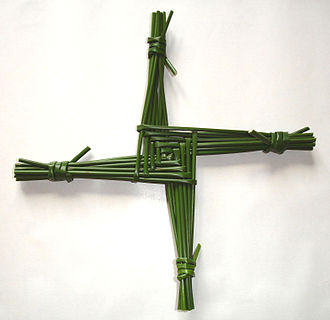
Here’s one on a gravestone in Ireland
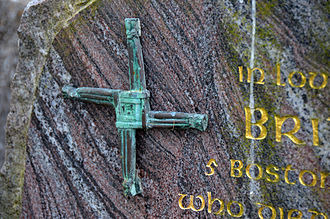
There’s also one of the floor of the Carlow Cathedral. Usually these crosses were placed over doorways and windows to protect homes from any kind of harm. We know that these symbols pre-date the Christian stories of Saint Brigid, because tradition states these crosses protected the home from fire, a belief that doesn’t exist in any of the Christian stories but does match up to Brigid’s pagan association with fire
6 notes
·
View notes
Text
Saints&Reading: Sun., Feb. 14, 2021
Forefeast of the Meeting of the Lord
Commemorated on February 1_by the new calendar
The Martyr Tryphon of Campsada near Apamea in Syria (250)

The Martyr Tryphon was born in one of the districts of Asia Minor – Phrygia, not far from the city of Apameia in the village of Kampsada. From his early years the Lord granted him the power to cast out devils and to heal various maladies. The inhabitants of his native city were once saved by him from starvation: Saint Tryphon by the power of his prayer forced back a plague of locusts that were devouring the bread grain and devastating the fields. Saint Tryphon gained particular fame by casting out a devil from the daughter of the Roman emperor Gordian (238-244). Helping everyone in distress, he asked but one fee – faith in Jesus Christ, by Whose grace he healed them.
When the emperor Decius (249-251) entered upon the imperial throne, there was a fierce persecution of Christians. A denunciation was made to the commander Akelinos that Saint Tryphon was bolding preaching faith in Christ and that he led many to Baptism. The saint was arrested and subjected to interrogation, at the time of which he fearlessly confessed his faith. They subjected him to harsh tortures: they beat at him with clubs, lacerated his body with iron hooks, they seared the wounds with fire, and led him through the city, having hammered iron nails into his feet. Saint Tryphon bravely endured all the torments, not giving out a single whimper. Finally, he was condemned to beheading with a sword. The holy martyr prayed before the execution, thanking God for strengthening him in his sufferings, and he besought of the Lord in particular to bless those who should call upon his name for help. Just as the soldiers suspended the sword over the head of the holy martyr, he placed his soul into the hands of God. This event occurred in the city of Nicea in the year 250. Christians wound the holy body of the martyr in a clean shroud and wanted to bury him in the city of Nicea, in which he suffered, but Saint Tryphon in a vision commanded them to take his body to his native land to the village of Kampsada. This was done.
Later on the relics of Saint Tryphon were transferred to Constantinople, and then to Rome. The holy martyr is accorded great veneration in the Russian Orthodox Church.
There exists a legend, that during the reign of tsar Ivan the Terrible at the time of an imperial hunt, a gerfalcon beloved by the tsar flew off. The tsar ordered the falconer Tryphon Patrikeev to find the flown off bird. The falconer Tryphon journeyed about through the surrounding forest, but without luck. On the third day, exhausted by long searching, he returned to Moscow to the place now called Mar'ina Grove, and in weariness he lay down to rest, fervently praying to his patron saint – the Martyr Tryphon, beseeching him for help. In a dream he saw a youth on a white horse, holding on his hand the imperial gerfalcon, and this youth said: "Take back the lost bird, go with God to the tsar and be not aggrieved about it". Having awakened, the falconer actually spotted the gerfalcon not far off on a pine tree. He then took it to the tsar and told about the miraculous help, received by him from the holy Martyr Tryphon. After a certain while the falconer Tryphon Patrikeev built a chapel on the spot where the saint appeared, and later on also there was a church in the name of the holy Martyr Tryphon.
© 1996-2001 by translator Fr. S. Janos.
St. Brigid of Ireland (523)
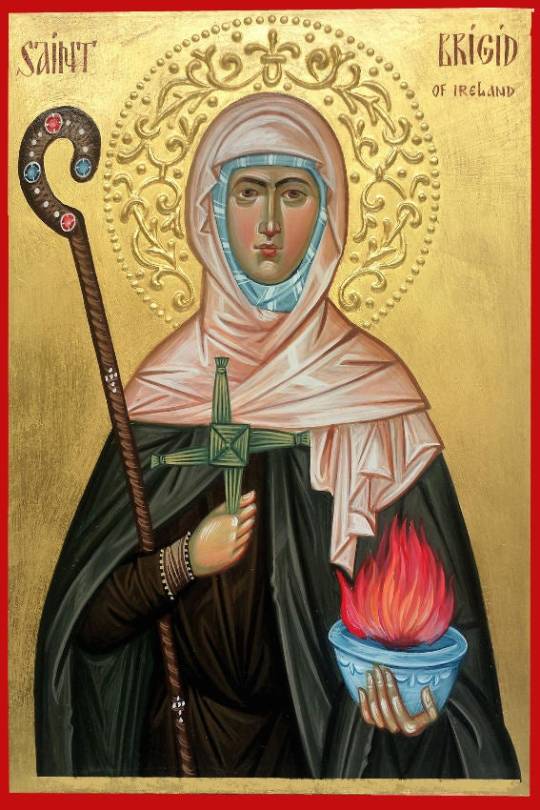
Her name is also spelled Brigit or Bridget; she is considered, equally with St Patrick (March 17), patroness of Ireland. She was born in Ulster of a noble Irish family which had been converted by St Patrick. She was uncommonly beautiful, and her father planned to marry her to the King of Ulster. But at the age of sixteen she asked her Lord Jesus Christ to make her unattractive, so that no one would marry her and she could devote herself to Him alone. Soon she lost an eye and was allowed to enter a monastery. On the day that she took monastic vows, she was miraculously healed and her original beauty restored.
Near Dublin she built herself a cell under an oak tree, which was called Kill-dara, or Cell of the Oak. Soon seven other young women joined her and established the monastery of Kill-dara, which in time became the cathedral city of Kildare. The monastery grew rapidly and became a double monastery with both men's and women's settlements, with the Abbess ranking above the Abbot; from it several other monasteries were planted throughout Ireland. (Combined men's and women's monastic communities are virtually unknown in the east, but were common in the golden age of the Irish Church).
The Saint predicted the day of her death and fell asleep in peace in 524, leaving a monastic Rule to govern all the monasteries under her care. During the Middle Ages her veneration spread throughout Europe.


Luke 19:1-10
1Then Jesus entered and passed through Jericho.2 Now behold, there was a man named Zacchaeus who was a chief tax collector, and he was rich.3 And he sought to see who Jesus was, but could not because of the crowd, for he was of short stature.4 So he ran ahead and climbed up into a sycamore tree to see Him, for He was going to pass that way.5 And when Jesus came to the place, He looked up and saw him, and said to him, "Zacchaeus, make haste and come down, for today I must stay at your house."6 So he made haste and came down, and received Him joyfully. 7 But when they saw it, they all complained, saying, "He has gone to be a guest with a man who is a sinner." 8Then Zacchaeus stood and said to the Lord, "Look, Lord, I give half of my goods to the poor; and if I have taken anything from anyone by false accusation, I restore fourfold."9And Jesus said to him, "Today salvation has come to this house, because he also is a son of Abraham;10for the Son of Man has come to seek and to save that which was lost.
1 Timothy 4:9-15
9This is a faithful saying and worthy of all acceptance.10 For to this end we both labor and suffer reproach, because we trust in the living God, who is the Savior of all men, especially of those who believe. 11 These things command and teach.12 Let no one despise your youth, but be an example to the believers in word, in conduct, in love, in spirit, in faith, in purity. 13 Till I come, give attention to reading, to exhortation, to doctrine.14Do not neglect the gift that is in you, which was given to you by prophecy with the laying on of the hands of the eldership.15 Meditate on these things; give yourself entirely to them, that your progress may be evident to all.
#orthodoxy#orthodox christianity#ancientchristianity#originofchristianity#spirituality#holyscriptures#gospel#sacredtexts#wisdom
8 notes
·
View notes
Text
my heart, a spinning arrow
introspective thoughts led to this. i’m tired, but i need to write more claude.
Rating: T
Genre: Hurt/Comfort, Friendship
Characters: Claude von Riegan & Byleth Eisner & Dimitri Alexandre Blaiddyd & Edelgard von Hresvelg
Words: 3,203
After the Battle at Gronder Field, Claude contemplates the path that has led here and the one that leads forward.
AO3
The fire in the Knight’s Hall is almost burnt to embers. Claude takes a drink from his flask and stares into the flickering orange glow. The flask is almost empty and he pauses, placing it down on the table in front of him as he leans forward, resting his arms on his knees. He stabs the poker into the fire, flipping the log and rejuvenating the fading flames. He places the power back down on the table in front of him and pushes his hands through his hair, exhaling slowly.
He’s wearing only a loose beige shirt and simple trousers. He had dropped his armour off with the smith after the battle and hasn’t returned to pick it up yet. He pulls his hands back and stares at the white scars on his wrists, palms, and fingertips. They seem to glow against the darkness of his skin.
Years of archery have given him rough calluses and more than a few of his scars are from simple mishandling of sharp arrows in battle. He still hasn’t rid his hands of their tremors completely even after years of watching his hand-fletched arrows sink into throats and arms and chests. He’s a master of finding the small gaps in armour, but he wishes he wasn’t.
This isn’t what he had intended when he had come to Fódlan. He had intended to bolster relationships with the Kingdom and the Empire and the Alliance using tricks and pretty words to knock down barriers and open the continent to the world. He had intended to strip away stereotypes and build a new, better world.
Now, instead, he has the blood of his old classmates on his hands.
Claude had hoped, futilely, that Dimitri might just stay dead after the Empire captured Fhirdiad. Of course, he could never be so lucky.
The chilling words Dimitri had shrieked a Gronder, a perfect pinnacle of a madman, still echo in Claude’s ears. Gronder had been kill or be killed and the way that Dimitri had advanced made that clear enough. He had advanced without mercy and cut down soldiers clothed in red and yellow without even flinching. Dimitri’s strength had been formidable and his army was relentless and Claude had known that he could not leave the Kingdom’s king to his own efforts.
It had taken four arrows to even slow Dimitri down and Claude knows, sitting in front of the fire now, that the only reason he’s still alive is because the rest of Dimitri’s classmates had not been as crazy as him.
Dimitri, wounded as he was, never made it to Edelgard before the Adrestian Emperor retreated. According to Hilda, he had certainly pursued her after the battle. Edelgard had at least been smart enough to retreat when she had been defeated, but Claude could not say the same for the King of Faerghus.
He still remembers the way that Edelgard had looked at him when he had flown over her, arrow knocked in Failnaught and aimed in her general direction. He had called her lovely and she had told him to leave.
Claude’s first shot had missed, but his second hadn’t. Only his practiced flight maneuvers had saved his life against her supernatural counter abilities. It had only taken two more shots, one imbued with the true power of his Relic, to send Edelgard on the retreat.
Claude had had the shot for the final blow, a perfect chink in her armour to bury his yellow-fletched arrow, but he couldn’t unsee Edelgard standing in the Cathedral during their time at the academy. She would stare angrily at the statue of Saint Seiros as if it was the cause of all of her problems. Claude doesn’t think she ever knew that he had followed her.
He understands her more than he wants to admit: her anger at the church, at the systems of Fodlan, even her methods to an extent.
In Almyra, conquest is the way of the world. Lords fight and kill for shreds of land and power and brothers and sisters turn on each other for the chance to rule. Claude understands war. It has shadowed him his whole life, but that does not mean that he agrees with Edelgard’s methods.
He does not agree with the fact that it means they must bear arms against people they had once considered friends. He does not agree with the fact that it means that it was him, not some Imperial soldier, who had put Dimitri out of his misery. He will take this secret to his grave if he has too.
Hilda knows because she saw him take the shot and she has covered for him. Hilda claims that it had been a sick twist of fate when Dimitri had pursued Edelgard that had brought the King of Faerghus to his unfortunate end. Her eyes study his face every time she repeats the lie.
Claude should have let him go and get cut down by the Imperial Army. Instead, in some twisted sense of pity and righteousness, it had been an arrow fired from Failnaught that found Dimitri’s throat and put an end to the mad prince. He sees it as a clean ending to an unfortunate life and a neat way to usher Fódlan to a new future.
That does not mean he does not regret it.
He had dropped Failnaught immediately after taking the shot, disgusted with himself, and only Hilda’s insistence that they draw back to the rest of the army had saved him from getting swarmed over by Imperial soldiers. She had carried the Relic almost all the way back to command for him when he had been unable to lay his hands on it.
The flames crack in front of him, drawing him back to the present, and Dimitri’s voice echoes in his head again. Claude wonders if Edelgard knows what he has done. He wonders if she would congratulate him or scorn him for his actions. She would have no right to do either, he reasons with himself.
Not with the way she had left Bernadetta and Petra to die.
Claude himself had never been particularly close to Bernadetta, but she was a quick and accurate shot, he had known that from archery competitions back at the academy. Unfortunately for Bernadetta, Edelgard had been content to leave her on the centre hill to draw fire. Raphael hadn’t even made it all the way to the centre hill before the Empire set it aflame.
Raphael had returned to base after the battle with a stony expression and a bloodied and burned body clutched in his arms. Leonie had helped him bury her and had reported to Claude later that her fatal injuries had come from the explosion, not any of the attacks from the Kingdom or Alliance.
Petra had been quick enough at least to dodge the explosion on the centre hill, but her evasion had placed her right in Claude’s path. His stomach twists and he digs his nails into his scalp as he recalls the shadow of his wyvern falling over the Brigid Princess.
She had taught him to climb trees five years ago and he had taught her to fly on a wyvern. She had not been afraid of him at that moment and it had only been the live or die instinct he had cultivated in himself since he was a child that had let him loose the arrow.
Petra had taken the blow and from him and Claude had had an opening to finish the job, but he had been unable to shoot again. He could only remember the laughs they had shared through his misadventures of falling out of trees and their honest discussion about nature and the nature of gods. She had pulled back, wounded and bleeding, with wild eyes filled with a fear that made him sick to his stomach even now.
Claude wants to yank his own hair out in his frustration. He has been trying to reduce the appearance of Almyrans as war-thirsty villains and he knows that having the princess of a foreign nation be afraid of him will not help with that fact when it comes time for him to claim the throne from his father. It will not help his Fódlan relations either for his friends to see him as the thoughtless killer he looked like.
Although, with the way this war keeps panning out, Claude sometimes wonders if he’ll have any friends left at all at the end of the war. The Golden Deer, once innocent and chaotic and fun, are splintering, shattered by the burdens of the heavy war they’ve been fighting for five years. Claude can see it in all of them: the bone-deep weariness that accompanies every swing of a weapon and every new scar earned.
His friends from the Kingdom are already gone. Gronder Field had seen to that. Annette, apparently, was lost in the five years of in-fighting between the Kingdom Loyalists and the Faerghus Dukedom. Ashe was burned in the fires of Ailell when he fell with House Rowe. Mercedes had fallen to Ignatz’s arrows at Gronder. Sylvain had buckled under the force of Lysithea’s magic. Felix had met his end by Leonie’s spear.
Claude had shot Ingrid out of the sky and left her for Hilda to finish off.
Dedue had vanished into the chaos of the battle, but Claude is not hopeful. One man, alone, who is anger-addled and revenge-filled does not stand a hope against the might of the Empire.
Claude lifts his head, dropping his hands to his lap and stares, dead-eyed at the flickering fire in front of him. The Kingdom will have died with Dimitri. If he fails now, stumbles at Edelgard’s doorstep, then the Alliance will follow the Kingdom down, as history has always dictated.
He drinks from his flask quickly enough that he nearly chokes on the burn of the liquor as he tosses it back. He has run the flask dry by now, drinking away the grief he tries to stave off with a well-timed joke or a sarcastic comment. He wonders if anyone sees through him.
Lorenz, maybe, at the worst of times, and Hilda, perhaps, at his best.
Claude has never been good at dealing with death. As a child, his mother told him story after story to desensitize him to the horrors of combat and the worlds that both of his ancestors originated from. It never worked. Instead, he found himself pitying both sides and grieving for people he had never met. His compassion had never been beaten out of him, as hard as some of his step-siblings may have tried.
Maybe that is why it hurts so much, even hours or days or weeks later, to know that old classmates have fallen and will fall. Maybe that’s why his hands are still sticky with Dimitri’s blood even though he had given the king a death that did not prolong his suffering.
He wants to kill Edelgard. He wants to bury an arrow in her heart and have her fall down dead and he wants the war to be over, but Claude is tired of fighting. He wants to find Rhea and ask her all the questions burning on his tongue, to know the truth of the Church of Seiros and the Relics and the Crest system and the eternally mysterious Professor who rose from the dead after five years of “sleeping”.
It’s as if he summons her, just by thinking of her. Her green hair, as faint as starlight, catches his eye from the corner of the hall where she stands, just inside the door as if she’s waiting for an invitation.
Claude leans back on the couch, trying to hide his weariness as he shoots her a smile. “Teach,” he says in greeting.
She steps closer. “Mind if I join you?”
“Depends on if you brought a drink,” he jokes.
He’s not serious, but the professor pulls her own flask from her belt and tosses it to him as she crosses the room. Claude fumbles, almost dropping it, but he calms his shaky hands by the time she reaches him and sinks into the couch next to him, staring into the fire in the same way that he had.
Claude unscrews the top on the flask and takes a swig. Her liquor is cheaper than his own and he resists the urge to wince as he drinks. He lowers the flask from his mouth and hands it off to her. She drinks easily, without even the twitch of her eyebrow. Claude barely catches the monogrammed ‘JE’ on the bottom of the flask while she drinks and he knows then why it is so easy for her.
“It’s strange to see you without your armour,” she comments quietly, staring at her hands where she clutches the flask.
He studies her face. As always, she is hard to read, but he can at least see the grief that is heavy in her expression. When they had met, she had been a blank slate. Now, he knows her well enough to see the edges of pain that she so desperately tries to conceal.
“It needs fixing. Figured there was no point in delaying when we need to start planning on how we’re going to hit Fort Merceus.”
“Tomorrow,” she says, cutting him off.
He blinks. “What?”
“We can start planning tomorrow,” she finishes. “I don’t want to think about fighting anymore tonight.”
“You know, Teach,” he says, “I never thought you’d be the one to tell me to stop working.”
She lifts her head, narrowing her eyes at him. “I drop by your room almost every day to tell you to get a reasonable amount of sleep.”
“And how much of that is completely hypocritical?” he counters easily.
She doesn’t rise to his jab and takes another drink from her father’s flask. They’re both silent for a moment as she swallows and slowly screws the squeaking cap back onto the top of the flask. She places it down on the table in front of them with a dull thud and picks up the fire poker. She pushes on one of the logs until it crumbles with a hiss and there’s a puff of smoke before the fire starts to fall apart, returning to embers.
“I should have killed her today,” the professor says without prompting.
Claude knows who she’s talking about. “I had the shot and I didn’t take it,” he confesses.
She looks at him, her green eyes glowing silver from the warm light of the fire. She looks almost ethereal in the orange glow. She is stunningly beautiful and always has been, but since her transformation after the Sealed Forest, there is something starkly otherworldly and unsettling about the way that she looks.
“I never would have asked you to,” she admits simply.
“Then don’t attempt to carry the burden of that by yourself,” he argues.
She shakes her head. “No, Claude, when we get to Enbarr, I will kill Edelgard myself.”
She draws the hunting dagger that is at her side at all times and flips it in her hand casually. The hilt is roughly bound in well-worn leather, but the blade is polished steel. She has carried the blade for as long as he has known her, but he has never once seen her use it.
“You don’t have to do that.”
“I want to.”
The three words are simple and chilling. Claude hesitates on his reply long enough that she sheaths her knife and drums her fingers over her leg like she is nervous. She does not look at him. He is unsure of how to tell her that he feels the same. That he felt the same when he killed Dimitri just hours earlier.
In the quiet moment that extends between them, there are so many things he wants to say to her. He wants to tell her about all of his doubts about the Church. He wants to confess his true upbringing. He wants to show her the faded healing scars on his hands and wrists and say which ones were his fault and which were the fault of others.
“Are you afraid of dying?” he asks instead.
“No,” she replies immediately. “At least, not usually.” She flexes the fingers of one hand and Claude swears that they sparkle with yellow light for a moment, but it is probably a trick of the lighting.
“I’m terrified of dying,” he admits. “There is so much left to be done and if I die, where does that leave any of this?”
She looks at him and he is taken aback by the warmth that lingers in her eyes. “I will not let you die.”
His lips twitch at the sentiment. It’s reassuring to hear from her, the woman who is a one-man army all on her own, but even she can’t stop what might happen in the coming days, especially with the plan that has been floating in his brain for several weeks.
“What would the goddess think of such words?” he asks, knowing full well that she knows he does not believe in the goddess like most of his former classmates do.
“I am inclined to believe I have the goddess on my side,” she says simply.
She is still looking at him and he does not doubt her. He never has.
“Alright then, Teach,” he says, nodding. “No dying for me.”
“Claude.”
She touches his wrist and his hand turns into her touch instinctively. Her thumb skitters over the skin on the underside of his wrist and up over the exposed part of his palm. She traces a bruise and a bump on his palm from a few bad draws on the field today and a knick on his thumb from the reigns of his wyvern.
She squeezes his hand and he feels her reassurance and her nervousness in the touch. This is not about the future of the nation: this is about the future of two young people who are just trying to survive.
“Byleth.”
He doesn’t often use her name, forgoing it for the sake of an affectionate and familiar nickname, but the moment calls for it. He tightens his own grip on her hand and nudges his knee against hers. He admires, for a moment, the dark of his skin against the fairness of hers and wonders what it would be like to hold her completely.
“We will be defined by this war as long as we are alive,” she points out, staring at their joined hands. “But we needn’t let it write the path to our future.”
“You lead,” he suggests. “I’ll follow.” When she frowns, he squeezes her hand. “I trust you.”
They don’t talk about Gronder Field or Fort Merceus or much of anything for the rest of the night, but when Byleth finally peels herself away to get some sleep, Claude feels the warmth of her hand linger in his and he can almost imagine a future filled with light instead of one darkened by war and memories of the dying screams of old friends.
It’s a reassuring thought.
#the writing section#my heart a spinning arrow#fic: my heart a spinning arrow#claude von riegan#c: claude von riegan#c: byleth#c: dimitri alexandre blaiddyd#c: edelgard von hresvelg#byleth#claudeleth#ship: claudeleth#r: t#g: hurt/comfort#g: friendship#words: 3.2k+#fire emblem three houses#f: fire emblem#dimitri alexandre blaiddyd#edelgard von hresvelg#verdant wind
19 notes
·
View notes
Text
What do you think are the secret fantasies of the FE Three Houses cast?
Interesting, I like it! This is only the playable characters (sans DLC), but if you’d like anyone else for either version, let me know! I’d be happy too :)
For the other version, click here!
~Latte ♡
FE: Three Houses Ensemble - Secret Fantasies
Black Eagles
Edelgard: to live somewhere no one can find her; she’s tired
Hubert: to form a Malig Knight/Dark Flier corps in the Empire
Ferdinand: to procure the finest collection of weapons on the continent
Linhardt: to create the best sleeping pillow
Caspar: to climb the highest peak in Fódlan (and shout it to the heavens once he gets there)
Petra: to formally introduce tattoos into Fódlan’s culture; many have meanings and can be a great way of expression!
Dorothea: to live a life she’s truly happy with, whether married or not; she wants to be fulfilled
Bernadetta: to weave a tapestry telling of her friends’ adventures
Blue Lions
Dimitri: to restore his relations with his stepsister; despite everything she’s done, somewhere, the little girl he knew is still there
Dedue: to establish a Duscur-style orphanage for the children of his homeland affected by the Tragedy, complete with a kitchen and greenhouse
Sylvain: to destroy the Lance of Ruin (and the other Relics along with it)
Felix: to spar with his brother again; even if he loses, he just wants Glenn to see how far he’s come
Ashe: to introduce foreign cuisine to Faerghus’ culture; the spices of Almyra and Brigid, the bitter flavors of Dagda, there so many combinations out there!
Ingrid: to breed and train the finest war horses and pegasi on the continent
Mercedes: to open a mount-friendly bakery where she makes treats for war veterans and their retired mounts
Annette: to combine music with magic, both to teach and to compose
Golden Deer
Claude: an orchard with fruit trees from all over; good for climbing, naps, and a snack
Lorenz: to grow and export the finest roses in Fódlan
Raphael: to found Fódlan’s first strongman league (or equivalent of)
Ignatz: to paint a mural on the cathedral ceiling (Sistine Chapel-style) depicting the history of the Church of Seiros
Hilda: to form a comfortable but practical and stylish clothing line for soldiers; have to look your best in battle, right?
Marianne: to establish an animal sanctuary for species endangered by the war and injured war mounts
Lysithea: a house made of cake; she’d use magic to keep it from spoiling
Leonie: a bow with endless arrows; she doesn’t like buying them
Church of Seiros
Seteth: to return to the Rhodos Coast and live the rest of his years there, with Flayn if she desires to return with him
Flayn: to explore the depths of the ocean to discover all of its secrets (and the many fish that call it home!)
Cyril: to become the first Almyran Holy Knight in the Church
Hanneman: to find the burial ground of the original holders of the Crests (Saints or Elites)
Manuela: a floor-to-ceiling self-portrait, tasteful nude Renaissance-style
Catherine: to restore her relations with her family and House Gaspard
Shamir: an endless supply of coffee; she’s too tired for war-harbinger teenagers
Alois: to catch the biggest fish in Fódlan
Gilbert: to learn Reason magic in order to better bond with Annette
Byleth: to meet Sothis physically, to hug her, to thank her in person
#fire emblem#Fire Emblem Three Houses#fe three houses#fe three houses headcanons#fire emblem headcanons#fe16#fe3h#black eagles#blue lions#golden deer#adrestian empire#holy kingdom of faerghus#leicester alliance#church of seiros#answered
84 notes
·
View notes
Photo

St Patrick’s Day is a global celebration of Irish culture on or around March 17. It particularly remembers St Patrick, one of Ireland’s patron saints, who ministered Christianity in Ireland during the fifth century.
What Do People Do?
St Patrick’s Day is celebrated in many parts of the world, especially by Irish communities and organizations. Many people wear an item of green clothing on the day. Parties featuring Irish food and drinks that are dyed in green food color are part of this celebration. It is a time when children can indulge in sweets and adults can enjoy a “pint” of beer at a local pub. Many restaurants and pubs offer Irish food or drink, which include:
Irish brown bread.
Corned beef and cabbage.
Beef and Guinness pie.
Irish cream chocolate mousse cake.
Irish coffee.
Irish potato champ, also known as poundies, cally or pandy.
Irish stew.
Irish potato soup.
Some people plan a pilgrimage to St Patrick’s Purgatory, which is commonly associated with penance and spiritual healing since the early 13th century. It is on Station Island in Lough Derg in County Donegal where St Patrick had a vision promising that all who came to the sanctuary in penitence and faith would receive a pardon for their sins.
Public Life
St Patrick's Day is a bank holiday in Northern Ireland (United Kingdom) and the Republic of Ireland. St Patrick’s Day is also a festive occasion in some parts of the world where it is not a public holiday. Therefore traffic and parking may be temporarily affected in streets and public areas where parades are held in towns and cities.
Background
St Patrick is one of the patron saints of Ireland. He is said to have died on March 17 in or around the year 493. He grew up in Roman Britain, but was captured by Irish raiders and taken to Ireland as a slave when he was a young adult. After some years he returned to his family and entered the church, like his father and grandfather before him. He later returned to Ireland as a missionary and worked in the north and west of the country.
According to popular legend, St Patrick rid Ireland of snakes. However, it is thought that there have been no snakes in Ireland since the last ice age. The "snakes" that St Patrick banished from Ireland, may refer to the druids or pagan worshipers of snake or serpent gods. He is said to be buried under Down Cathedral in Downpatrick, Ireland. Ireland’s other patron saints are St Brigid and St Columba.
Luke Wadding, a Franciscan scholar born in 1588 in Waterford, on the south coast of Ireland, was influential in ensuring that the anniversary of St Patrick's death became a feast day in the Catholic Church. Many Catholic churches traditionally move St Patrick's Day to another date if March 17 falls during Holy Week.
Many immigrants from Ireland fled to other parts of the world, including Australia, Canada, the United Kingdom and the United States, in the 19th and 20th centuries. Many Irish customs, including the St Patrick’s Day celebrations, became quite popular in these countries. However, much of the interest in the St Patrick’s Day events is largely commercially driven in the 21st century.
Symbols
The most common St Patrick's Day symbol is the shamrock. The shamrock is the leaf of the clover plant and a symbol of the Holy Trinity. Many people choose to wear the color green and the flag of the Republic of Ireland is often seen in St Patrick’s Day parades around the world. Irish brands of drinks are popular at St Patrick’s Day events.
Religious symbols include snakes and serpents, as well as the Celtic cross. Some say that Saint Patrick added the Sun, a powerful Irish symbol, onto the Christian cross to create what is now called a Celtic cross. Other Irish-related symbols seen on St Patrick’s Day include the harp, which was used in Ireland for centuries, as well as a mythological creature known as the leprechaun and a pot of gold that the leprechaun keeps hidden.
We diligently research and continuously update our holiday dates and information. If you find a mistake, please let us know.
Advertising
Other Names and LanguagesEnglishSt. Patrick's Day
FrenchFête de la Saint-Patrick
GermanSt. Patrick's Day
IrishLá Fhéile Pádraig
NorwegianSt. Patricks dag
SpanishDía de San Patricio
St. Patrick's Day in …
Australia
Canada
Ireland
United Kingdom
United States
1 note
·
View note
Photo
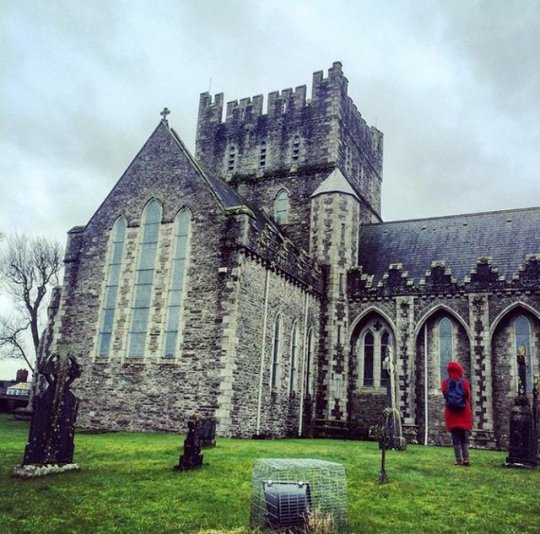
Saint Brigid's cathedral, Co Kildare. It was consecrated in AD 1230
163 notes
·
View notes
Text
Today the Church remembers St. Welted of Riveaulx, Monk.
Ora pro nobis.
Aelred of Rievaulx (1110 – 12 January 1167 AD) was an English Cistercian monk, abbot of Rievaulx, in Yorkshire, England, from 1147 AD until his death. He was also a writer of several theological volumes.
Aelred was born in Hexham, Northumbria, in 1110, one of three sons of Eilaf, priest of St. Andrew's at Hexham, himself a son of another Eilaf, treasurer of Durham. In 1095, the Council of Claremont had forbidden the ordination of the sons of priests. This was done in part to end the inheritance of benefices.[3] He may have been partially educated by Lawrence of Durham, who sent him a hagiography of Saint Brigid.
Aelred's early education was probably at the cathedral school at Durham. Aelred spent several years at the court of King David I of Scotland in Roxburgh, possibly from the age of 14, rising to the rank of echonomus (often translated "steward" or "Master of the Household") before leaving the court at age twenty-four (in 1134) to enter the Cistercian abbey of Rievaulx in Yorkshire.
In 1138, when Rievaulx's patron, Walter Espec, was to surrender his castle at Wark to King David of Scotland, Aelred reportedly accompanied Abbot William of Rievaulx to the Scottish border to negotiate the transfer. He saw that his reluctance to part from his friends at court, delayed his adopting his monastic calling. For Aelred, the source and object of true friendship is Christ.
In 1142 Aelred travelled to Rome, alongside Walter of London, Archdeacon of York, to represent before Pope Innocent II the northern prelates who opposed the election of Henry de Sully, nephew of King Stephen, as archbishop of York. The result of the journey was that Aelred brought back a letter from Pope Innocent summoning the superiors whom Aelred represented to appear in Rome the following March to make their deposition in the required canonical form. The resulting negotiations dragged on for many years.
Upon his return from Rome, Aelred became novice master at Rievaulx. In 1143, he was appointed abbot of the new Revesby Abbey, a daughter house of Rievaulx in Lincolnshire. In 1147, he was elected abbot of Rievaulx itself, a position he was to hold until his death. Under his administration, the abbey is said to have grown to some 140 monks and 500 conversi and laymen.
His role as abbot required him to travel. Cistercian abbots were expected to make annual visitations to daughter-houses, and Rievaulx had five in England and Scotland by the time Aelred held office. Moreover, Aelred had to make the long sea journey to the annual general chapter of the Order at Cîteaux in France.
Alongside his role as a monk and later abbot, Aelred was involved throughout his life in political affairs. The fourteenth-century version of the Peterborough Chronicle states that Aelred's efforts during the twelfth-century papal schism brought about Henry II's decisive support for the Cistercian candidate, resulting in 1161 in the formal recognition of Pope Alexander III.
Aelred wrote several influential books on spirituality, among them Speculum caritatis ("The Mirror of Charity," reportedly written at the request of Bernard of Clairvaux) and De spiritali amicitia ("On Spiritual Friendship").
He also wrote seven works of history, addressing three of them to Henry II of England, advising him how to be a good king and declaring him to be the true descendant of Anglo-Saxon kings.
In his later years, he is thought to have suffered from the kidney stones and arthritis. Walter reports that in 1157 the Cistercian General Council allowed him to sleep and eat in Rievaulx's infirmary; later he lived in a nearby building constructed for him.
Aelred died in the winter of 1166–7, probably on 12 January 1167, at Rievaulx.
O God, by whose grace your servant Aelred, kindled with the flame of your love, became a burning and a shining light in your Church: Grant that we also may be aflame with the spirit of love and discipline, and walk before you as children of light; through Jesus Christ our Lord, who lives and reigns with you, in the unity of the Holy Spirit, one God, now and forever. Amen.
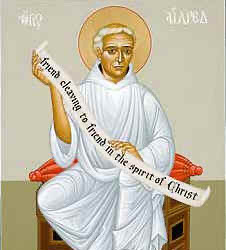
#father troy beecham#christianity#troy beecham episcopal#jesus#father troy beecham episcopal#saints#god#salvation#peace#monasticism
5 notes
·
View notes
Text
Prompt #14: Part
FFXIV 30 Day Writing Challenge
Prompt 14: Part
Lord and Lady Elant Bertennant Diarmuid Lonán Orraux Argentum
request the honour of your presence
at the marriage of
Miss Brigid Océane Aine O’Donnell
to
their son
Lord Iolaire Elant Ádhamn Caoimhín Orraux Argentum
Waterday, the tenth sun of the First Umbral Moon
Seventh Astral Era Two
at six bells
Saint Reymanaud’s Cathedral
The Holy See of Ishgard
Arthur put the invitation down on the table and blinked at Brigid. “Not the Sanctum of the Twelve?” he asked, eyebrow raised.
“Mum and Da dinnae marry in the Sanctum,” Brigid pointed out as she set a cup of tea next to Arthur’s hand. “Nay like I’m needin’ to be upholdin’ some grand tradition on our ends.”
He took the cup and started spooning sugar into it. “Bri, I’m not convinced Mum and Da were married in the first place.” A couple of spoonfuls later he took a drink, nodding to himself.
She waved and sat down at the table with her own cup of tea, along with a lemon tart. “Nay like ‘tis matterin’ anyway,” she murmured, adding spoonful after spoonful of sugar into her tea. “‘Sides, ‘tis matterin’ to his family, and nay any great hardship for me. ‘Tis the location matterin’, so long as I’m marryin’ him?”
Arthur hummed, sipping his tea again. He picked the invitation back up, eyes sliding over it as he read it one more time. “They’re fancy,” he commented, and Brigid sighed.
“Even poor Tataru’s worryin’ she willnae be able to be makin’ a fancy ‘nough weddin’ dress,” she admitted, leaning back in her chair. “Even for a second wife.”
“Knowing Miss Tataru she’ll likely make something the likes of which they’ve never seen,” her reassured her. “And if they hold it against you for being his second wife they can all go to rot.”
Brigid laughed and patted the table next to Arthur’s hand fondly. “You’re a good wee brother,” she praised, smiling lightly. “Bein’ better than Liam right now, certainly.”
“I’m sure he’ll come around. They’re both dragoons, they can go kill a dragon as a bonding exercise or something. Take Estinien along so that they don’t come to blows against each other.”
She laughed again and finally served the lemon tart. “Aye, I’ll have to be suggestin’ it. Or be sendin’ them to the Behemoth’s Den for a day or so. Thank you darlin’.”
“Of course.” He sipped his tea again, still studying the invitation. “Do you mind if I give one of these to Professor Synnove?”
“Nay, the more the merrier!”
#FFXIVWrite2020#FFXIVWrite#Warrior of Light: Brigid O'Donnell#Warrior of Light: Arthur O'Donnell#Pairing: For the Dancing and the Dreaming
7 notes
·
View notes
Photo

Saint of the Day – St Brigid of Ireland/Kildare (c 453-523) Virgin, Abbess, Apostle of Charity and foundress of several monasteries of nuns, including that of Kildare in Ireland, which was famous and was revered – born in 453 at Faughart, County Louth, Ireland and died on 1 February 523 at Kildare, Ireland of natural causes. Patronages – Ireland, babies, blacksmiths, boatme, brewers, cattle, chicken farmers, children whose parents are not married, children with abusive fathers, children born into abusive unions, Clan Douglas, dairymaids, dairy workers, Florida, fugitives, Leinster, mariners, midwives, milk maids, nuns, poets, the poor, poultry farmers, printing presses, sailors, scholars, travellers, watermen.

St Bride (Brigid) Carried By Angels, a painting by Scottish artist, John Duncan, 1913.
Next to the glorious St Patrick, St Brigid, whom we may consider his spiritual daughter in Christ, has ever been held in singular veneration in Ireland.
Historians say we know a lot more about St Brigid than we have facts, a polite way of saying that legends swirl about Ireland’s most celebrated woman. But even legends may have cores of truth. And some miracle stories are not legends at all but true accounts of God’s interventions.
Brigid was the daughter of a slave woman and a chieftain, who liberated her at the urging of his overlord. As a girl she sensed a call to become a nun and St Mel, bishop of Armagh, received her vows. Before Brigid, consecrated virgins lived at home with their families. But the saint, imitating Patrick, began to assemble nuns in communities, a historic move which enriched the church in Ireland.
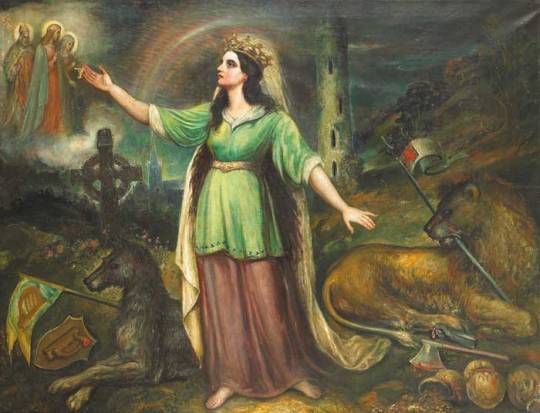
In 471, Brigid founded a monastery for both women and men at Kildare. This was the first convent in Ireland and Brigid was the abbess. Under her leadership Kildare became a centre of learning and spirituality. Her school of art fashioned both lovely utensils for worship and beautifully illustrated manuscripts. Again following Patrick’s model, Brigid used Kildare as a base and built convents throughout the island. The renown of Brigid’s unbounded charity drew multitudes of the poor to Kildare, the fame of her piety attracted thither many persons anxious to solicit her prayers or to profit by her holy example. In course of time the number of these so much increased that it became necessary to provide accommodation for them in the neighbourhood of the new monastery and thus was laid the foundation and origin of the town of Kildare.
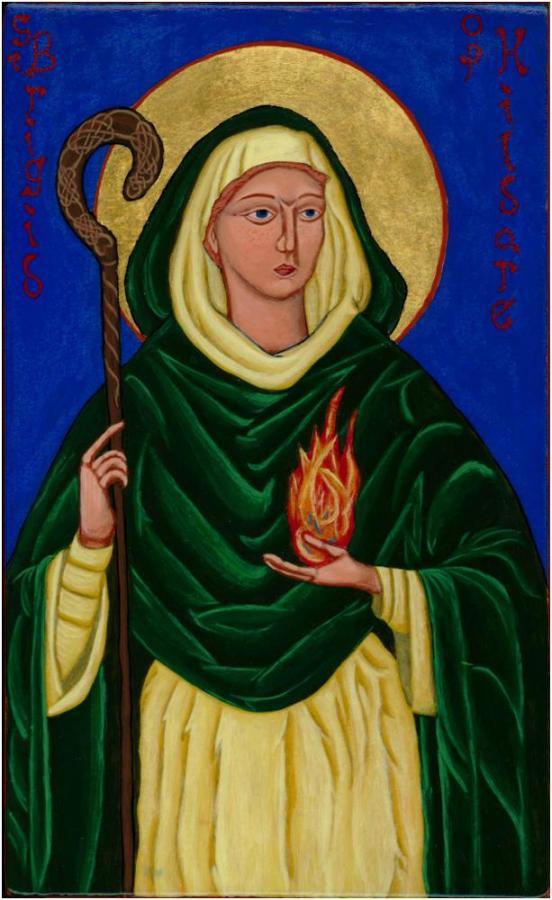
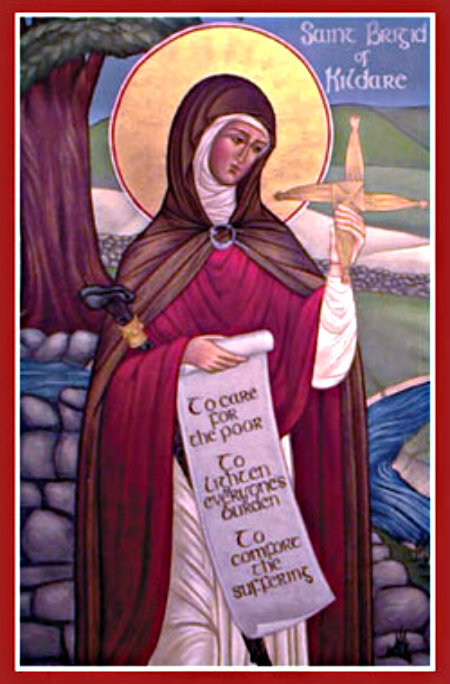
Brigid’s hallmark was uninhibited, generous giving to anyone in need. Many of the saint’s earliest miracles seem to have rescued her from punishment for having given something to the poor that was intended for someone else. For example, once as a child she gave a piece of bacon to a dog and was glad to find it replaced when she was about to be disciplined. Brigid exhibited this unbounded charity all her life, giving away valuables, clothing, food—anything close by—to anyone who asked.

One of the most appealing things told of Brigid is her contemporaries’ belief that there was peace in her blessing. Not merely did contentiousness die out in her presence but just as by the touch of her hand she healed leprosy, so by her very will for peace she healed strife and laid antiseptics on the suppurating bitterness that foments it.
In the ninth century, the country being desolated by the Danes, the remains of St Brigid were removed in order to secure them from irreverence and, being transferred to Down-Patrick, were deposited in the same grave with those of the glorious St Patrick. Their bodies, together with that of St Columba, were translated afterwards to the cathedral of the same city but their monument was destroyed in the reign of King Henry VIII. The head of St Brigid is now kept in the church of the Jesuits at Lisbon.

Saint Brigid’s Cross
A special type of cross known as “Saint Brigid’s cross” is popular throughout Ireland. It commemorates a famous story in which Brigid went to the home of a pagan leader when people told her that he was dying and needed to hear the Gospel message quickly. When Brigid arrived, the man was delirious and upset, unwilling to listen to what Brigid had to say. So she sat with him and prayed and while she did, she took some of the straw from the floor and began weaving it into the shape of a cross. Gradually the man quieted down and asked Brigid what she was doing. She then explained the Gospel to him, using her handmade cross as a visual aid. The man then came to faith in Jesus Christ and Brigid baptised him just before he died.Today, many Irish people display a Saint Brigid’s cross in their homes, since it is said to help ward off evil and welcome good. Brigid died in 523 and after her death people began to venerate her as a saint, praying to her for help seeking to heal from God, since many of the miracles during her lifetime related to healing.
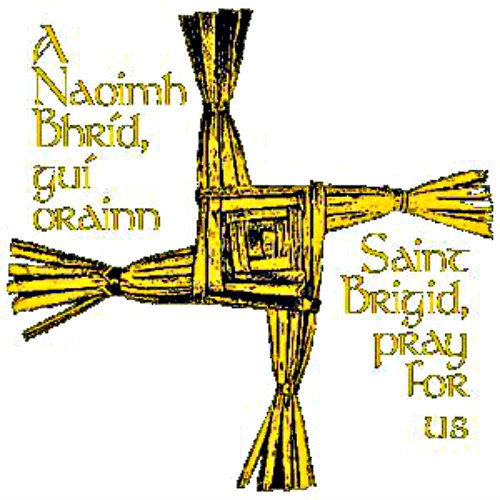
Blessing of St Brigid’s Crosses
Father of all creation and Lord of Light,
You have given us life and entrusted Your creation to us, to use it and to care for it.
We ask You to bless these crosses made of green rushes in memory of holy Brigid,
who used the cross to recall and to teach Your Son’s life, death and resurrection.
May these crosses be a sign of our sharing in the Paschal Mystery of your Son
and a sign of Your protection of our lives, our land and its creatures,
through Brigid’s intercession, during the coming year and always.
We ask this through Christ our Lord.
The crosses are then sprinkled with holy water:
May the blessing of God, Father, Son and Holy Spirit
be on these crosses and on the places where they hang
and on everyone who looks at them.
Amen
(via Saint of the Day - St Brigid of Ireland/Kildare (c 453-523))
#stbrigidofireland#stbrigidofkildare#february1stbrigidofireland#stbrigid'scross#blessingofstbrigid'scross#catholic#myedits#myedit#catholicism
34 notes
·
View notes
Text

SAINTS DECEMBER 29
St. Thomas Becket, Roman Catholic Priest and English Martyr. was Archbishop of Canterbury from 1162 until his murder in 1170. He is venerated as a saint and martyr by both the Catholic Church and the Anglican Communion. He engaged in conflict with Henry II of England over the rights and privileges of the Church and was murdered by followers of the king in Canterbury Cathedral. Soon after his death, he was canonised by Pope Alexander III. Feastday
From statesman to martyr: Thomas à Becket was Chancellor to his friend, the English King Henry II, who willed that he become Archbishop of Canterbury, opposed his friend the king to defend the rights and liberties of the Church. He was killed in Canterbury Cathedral on December 29, 1170.
https://www.vaticannews.va/en/saints/12/29/st--thomas--becket--bishop-of--canterbury--martyr.html
Bl. William Howard, 1680 A.D.
Martyr of England. He was born the son of Thomas, earl of Arundel, in 1616 and raised a Catholic. The grandson of Blessed Philip Howard and a member of the noble family of the Howards, William held the title of Viscount Stafford. He was made a Knight of the Bath by King Charles I (r.1624-1649), and married Mary Stafford in 1637. In 1640, William was named Baron Stafford. A county in Virginia in the United States bears his name. He was arrested on the false accusation of complicity in the so-called Popish Plot and imprisoned for two years before finally being beheaded on Tower Hill on December 29. He was beatified in 1929
St. Aileran, 664 A.D. Monk, biographer, and scholar. Also called Sapiens the Wise. Aileran was one of the most distinguished professors at the school of Clonard in Ireland. St. Finian welcomed Aileran to Clonard. In 650, Aileran became rector of Clonard, and was recognized as a classical scholar and a master of Latin and Greek. He wrote The Fourth Life of St. Patrick, a Latin-Irish Litany and The Lives of St. Brigid and St. Fechin of Fore. His last work was a treatise on the genealogy of Christ according to St. Matthew. A fragment of another of Aileran's works has survived: A Short Moral Explanation of the Sacred Names. Scholarly institutions across Europe read this work aloud annually. Aileran died from the Yellow Plague. His death on December 29, 664 is chronicled in the Annals of Ulster.
0 notes